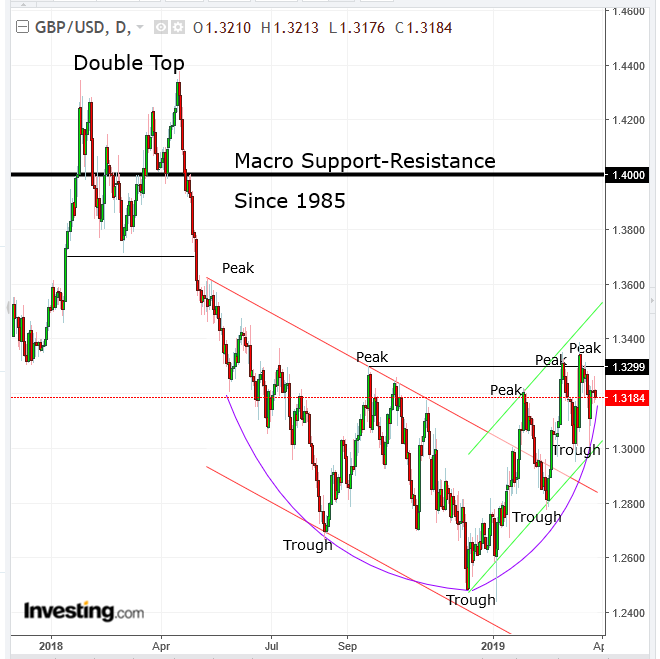Brexit’s potential disruption to the financial system in general, and U.K. assets in particular, has proliferated news headlines ever since the country voted to leave the EU. It may therefore be surprising to learn that for March, the pound is the second-best performing currency, lagging only the safe-haven yen.
Even more surprising perhaps, it's the top performing currency year-to-date. In fact, the pound may be gearing up for an upside breakout.
To be sure, the pound is still being punished for the U.K.’s Brexit decision. In the 31 years since 1985, until June 2016, the currency’s bottom was 1.4000.
The fateful referendum vote on June 23, 2016 pushed sterling below that level for the first time in over three decades. The former staunch support level then turned into a resistance. This reversal was demonstrated at the beginning of 2018, when sterling made four valiant attempts to break free of the 1.4000 resistance, only to form a double-top reversal and buckle below 1.2500, the lowest level for the currency since 1985.
Since the vote, despite the pound's twists and turns amid the ongoing Brexit drama, overall sentiment has been pessimistic. Yet, the pound has been demonstrating unique resilience.

Sterling bottomed on Dec. 11, the turning point from the downtrend within a descending channel. This framed a descending series of peaks and troughs, reversing into an uptrend within an ascending channel, building an ascending series of peaks and troughs.
The curvature of the trend reversal has been forming a rounding bottom formation, a pattern with high success of predicting a longer-term reversal. However, the absence of a definitive level, due to the pattern’s curvature makes it challenging to call it a longer-term bottom.
Our pick for a neckline is the 1.3300 level, since that was the final peak of the downtrend. Note that the price has not yet been able to remain above that level. It’s also interesting that the height of the rounding bottom according to our neckline is 800 pips, just about the same distance between the current price to the 1.4000, 31 year, support-resistance level.
The pound could get a double boost: Brexit hardliner Jacob Rees-Mogg's indication he may be willing to back Theresa May’s deal could increase demand for the currency. On the other side of the exchange rate, the Fed’s recently drastic dovish turn — compounded by Stephen Moore, President Donald Trump’s pick for an open Fed board seat, telling the New York Times the Fed should immediately slice away fifty basis points off interest rates — after the first real yield curve inversion since 2007, may reduce the dollar's popularity.
Now that the U.K. parliament has taken charge of Brexit, the conflict with Theresa May is eliminated, potentially bringing some stability into an uncertain market, sparking a pound rally at least strong enough to retest the 1.4000 psychological level.
